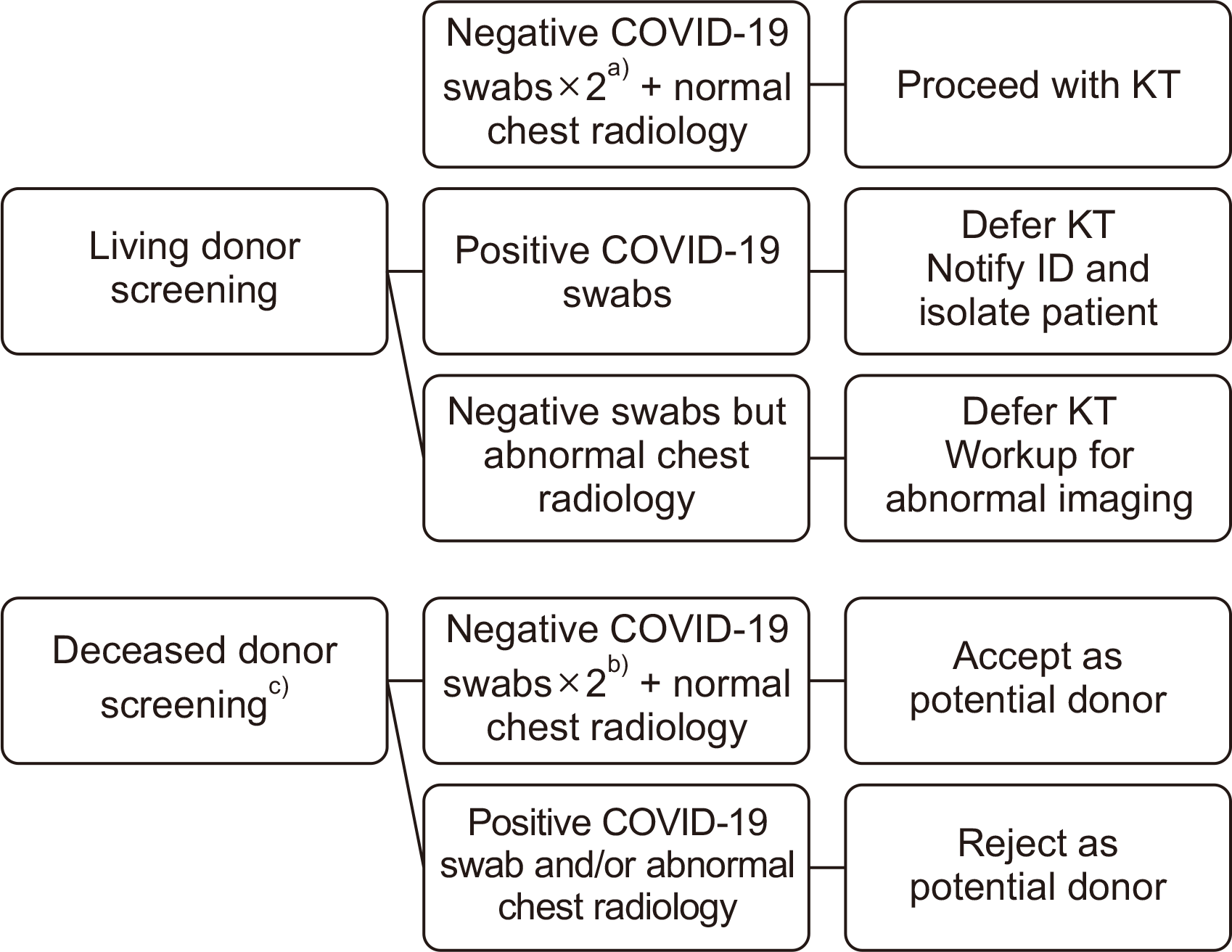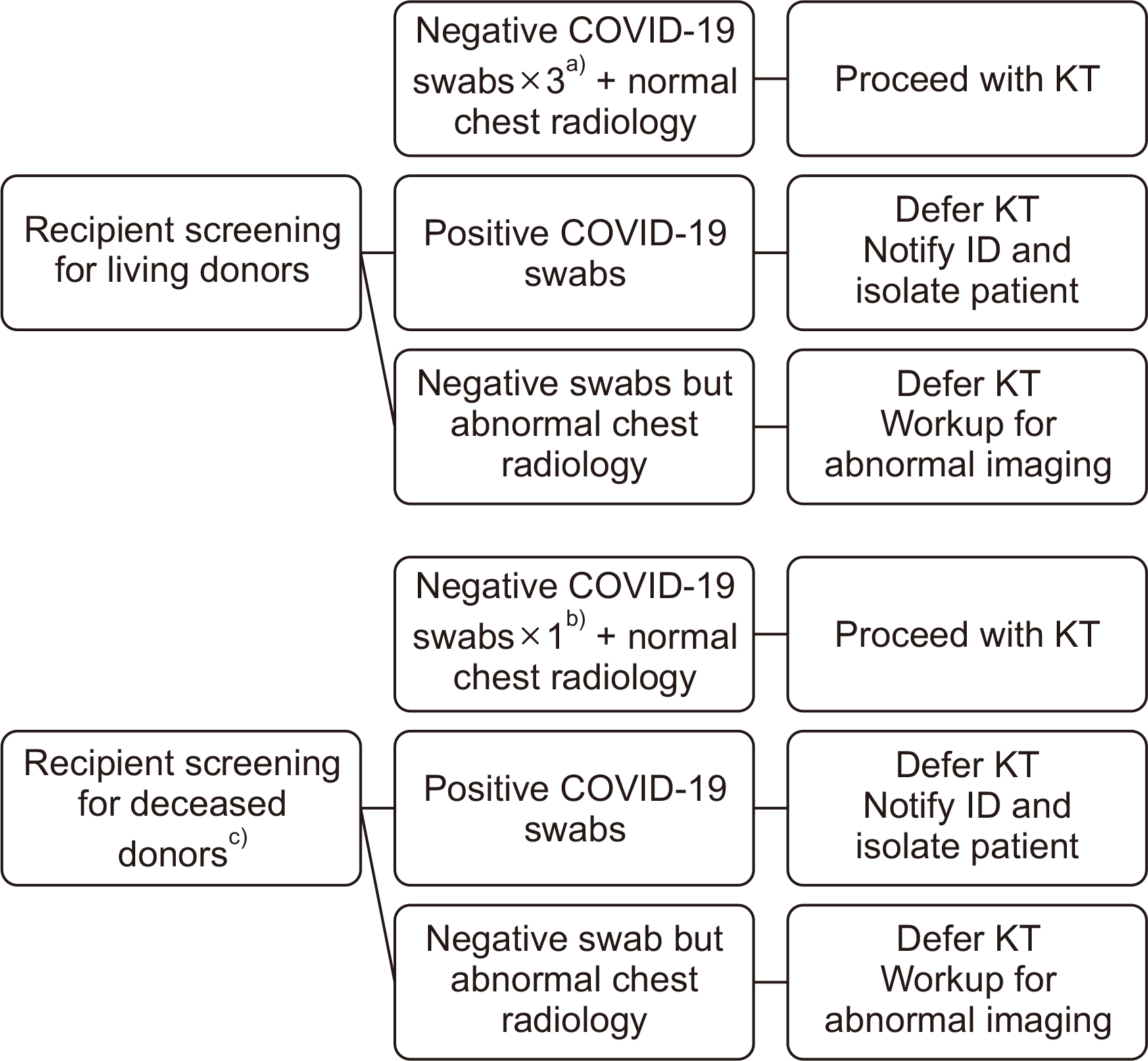1. Ministry of Health, Singapore (MOH). 2023. COVID-19 statistics [Internet]. MOH;Available from:
https://www.moh.gov.sg. cited 2022 Dec 1.
2. Kee T, Jeong JC, Ur-Rashid H, Begum NA, Arakama MH, Danguilan R, et al. 2021; Clinical characteristics, outcomes, and management of COVID-19 in kidney transplant recipients across Asia: an ASTREGO report. Korean J Transplant. 35:218–29. DOI:
10.4285/kjt.21.0024. PMID:
35769859. PMCID:
PMC9235460.

3. Kremer D, Pieters TT, Verhaar MC, Berger SP, Bakker SJ, van Zuilen AD, et al. 2021; A systematic review and meta-analysis of COVID-19 in kidney transplant recipients: lessons to be learned. Am Transplant. 21:3936–45. DOI:
10.1111/ajt.16742. PMID:
34212499. PMCID:
PMC9292797.

5. Mohamed IH, Chowdary PB, Shetty S, Sammartino C, Sivaprakasam R, Lindsey B, et al. 2021; Outcomes of renal transplant recipients with SARS-CoV-2 infection in the eye of the storm: a comparative study with waitlisted patients. Transplantation. 105:115–20. DOI:
10.1097/TP.0000000000003406. PMID:
33350626.

6. Jager KJ, Kramer A, Chesnaye NC, Couchoud C, Sánchez-Álvarez JE, Garneata L, et al. 2020; Results from the ERA-EDTA Registry indicate a high mortality due to COVID-19 in dialysis patients and kidney transplant recipients across Europe. Kidney Int. 98:1540–8. DOI:
10.1016/j.kint.2020.09.006. PMID:
32979369. PMCID:
PMC7560263.

7. Goffin E, Candellier A, Vart P, Noordzij M, Arnol M, Covic A, et al. 2021; COVID-19-related mortality in kidney transplant and haemodialysis patients: a comparative, prospective registry-based study. Nephrol Dial Transplant. 36:2094–105. DOI:
10.1093/ndt/gfab200. PMID:
34132811. PMCID:
PMC8394823.
8. Meier-Kriesche HU, Port FK, Ojo AO, Rudich SM, Hanson JA, Cibrik DM, et al. 2000; Effect of waiting time on renal transplant outcome. Kidney Int. 58:1311–7. DOI:
10.1046/j.1523-1755.2000.00287.x. PMID:
10972695.

9. Ho QY, Chung SJ, Gan VH, Ng LG, Tan BH, Kee TY. 2020; High-immunological risk living donor renal transplant during the COVID-19 outbreak: uncertainties and ethical dilemmas. Am J Transplant. 20:1949–51. DOI:
10.1111/ajt.15949. PMID:
32337825. PMCID:
PMC7267290.

10. Tan EK, Koh YX, Kee T, Juhari JB, Tan TE, Sim DK, et al. 2020; Waitlisted transplant candidates' attitudes and concerns toward transplantation during COVID-19. Ann Transplant. 25:e926992. DOI:
10.12659/AOT.926992. PMID:
33289727. PMCID:
PMC7735226.

11. Couzi L, Manook M, Caillard S, Épailly É, Barrou B, Anglicheau D, et al. 2021; Impact of Covid-19 on kidney transplant and waiting list patients: lessons from the first wave of the pandemic. Nephrol Ther. 17:245–51. DOI:
10.1016/j.nephro.2020.12.004. PMID:
33541842. PMCID:
PMC7791308.

12. Thind AK, Beckwith H, Dattani R, Dhutia A, Gleeson S, Martin P, et al. 2021; Resuming deceased donor kidney transplantation in the COVID-19 era: what do patients want? Transplant Direct. 7:e678. DOI:
10.1097/TXD.0000000000001126. PMID:
33688577. PMCID:
PMC7935425.

13. Heldman MR, Kates OS, Safa K, Kotton CN, Georgia SJ, Steinbrink JM, et al. 2022; Changing trends in mortality among solid organ transplant recipients hospitalized for COVID-19 during the course of the pandemic. Am J Transplant. 22:279–88. DOI:
10.1111/ajt.16840. PMID:
34514710. PMCID:
PMC8653312.

14. Cochran W, Shah P, Barker L, Langlee J, Freed K, Boyer L, et al. 2022; COVID-19 clinical outcomes in solid organ transplant recipients during the Omicron surge. Transplantation. 106:e346–7. DOI:
10.1097/TP.0000000000004162. PMID:
35404880. PMCID:
PMC9213060.

15. Ministry of Health, Singapore. Advisory on health measures for organ and tissue recovery and transplantation: COVID-19 Dorscon Orange. Ministry of Health, Singapore;2020.
16. Ministry of Health, Singapore. Update to booster vaccine recommendations. Ministry of Health, Singapore;2022.
18. Liew IT, Tan WJ, Ho QY, Thangaraju S, Yong JH, Ng E, et al. 2022; COVID-19 infected kidney transplant patients outpatient management-a single-center experience with a hospital-at-home program. Transplantation. 106:e525–7. DOI:
10.1097/TP.0000000000004379. PMID:
36173624. PMCID:
PMC9696754.

19. Lee J, Kim EJ, Ihn K, Lee JG, Joo DJ, Kim MS, et al. 2020; The feasibility of organ transplantation during the COVID-19 outbreak: experiences from South Korea. Korean J Transplant. 34:257–64. DOI:
10.4285/kjt.20.0048. PMID:
35770112. PMCID:
PMC9187045.

20. Jha PK, Yadav DK, Siddini V, Bansal SB, Sharma R, Anandh U, et al. 2021; A retrospective multi-center experience of renal transplants from India during COVID-19 pandemic. Clin Transplant. 35:e14423. DOI:
10.1111/ctr.14423. PMCID:
PMC8420412.

21. Tsapepas D, Paget K, Mohan S, Cohen DJ, Husain SA. 2021; Clinically significant COVID-19 following SARS-CoV-2 vaccination in kidney transplant recipients. Am J Kidney Dis. 78:314–7. DOI:
10.1053/j.ajkd.2021.05.004. PMID:
34019949. PMCID:
PMC8129995.

22. Ravanan R, Mumford L, Ushiro-Lumb I, Callaghan C, Pettigrew G, Thorburn D, et al. 2021; Two doses of SARS-CoV-2 vaccines reduce risk of death due to COVID-19 in solid organ transplant recipients: preliminary outcomes from a UK registry linkage analysis. Transplantation. 105:e263–4. DOI:
10.1097/TP.0000000000003908. PMID:
34310530. PMCID:
PMC8549134.








 PDF
PDF Citation
Citation Print
Print



 XML Download
XML Download